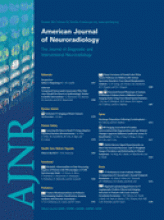Abstract
BACKGROUND AND PURPOSE: CT perfusion data sets are commonly acquired using a temporal resolution of 1 image per second. To limit radiation dose and allow for increased spatial coverage, the reduction of temporal resolution is a possible strategy. The aim of this study was to evaluate the effect of reduced temporal resolution in CT perfusion scans with regard to color map quality, quantitative perfusion parameters, ischemic lesion extent, and clinical decision-making when using DC and MS algorithms.
MATERIALS AND METHODS: CTP datasets from 50 patients with acute stroke were acquired with a TR of 1 second. Two-second TR datasets were created by removing every second image. Various perfusion parameters (CBF, CBV, MTT, TTP, TTD) and color maps were calculated by using identical data-processing settings for 2-second and 1-second TR. Color map quality, quantitative region-of-interest-based perfusion measurements, and TAR/NVT lesions (indicated by CBF/CBV mismatch) derived from the 2-second and 1-second processed data were statistically compared.
RESULTS: Color map quality was similar for 2-second versus 1-second TR when using DC and was reduced when using MS. Regarding quantitative values, differences between 2-second and 1-second TR datasets were statistically significant by using both algorithms. Using DC, corresponding tissue-at-risk lesions were slightly smaller at 2-second versus 1-second TR (P < .05), whereas corresponding NVT lesions showed excellent agreement. With MS, corresponding tissue-at-risk lesions showed excellent agreement but more artifacts, whereas NVT lesions were larger (P < .001) compared with 1-second TR. Therapeutic decisions would have remained the same in all patients.
CONCLUSIONS: CTP studies obtained with 2-second TR are typically still diagnostic, and the same therapy would have been provided. However, with regard to perfusion quantitation and image-quality–based confidence, our study indicates that 1-second TR is preferable to 2-second TR.
Abbreviations
- ASPECTS
- Alberta Stroke Program Early CT Score
- CBF
- cerebral blood flow
- CBV
- cerebral blood volume
- CTA
- CT angiography
- CTP
- CT perfusion
- DC
- deconvolution
- GM
- gray matter
- MS
- maximum slope
- MTT
- mean transit time
- N/A
- not applicable
- NCCT
- noncontrast CT
- NVT
- nonviable tissue
- PCA
- posterior cerebral artery
- ROI
- region of interest
- TAC
- time attenuation curve
- TAR
- tissue at risk
- TTD
- time to drain
- TTP
- time to peak
- TR
- temporal resolution
- TTS
- time to start
- WM
- white matter
- © 2011 by American Journal of Neuroradiology












